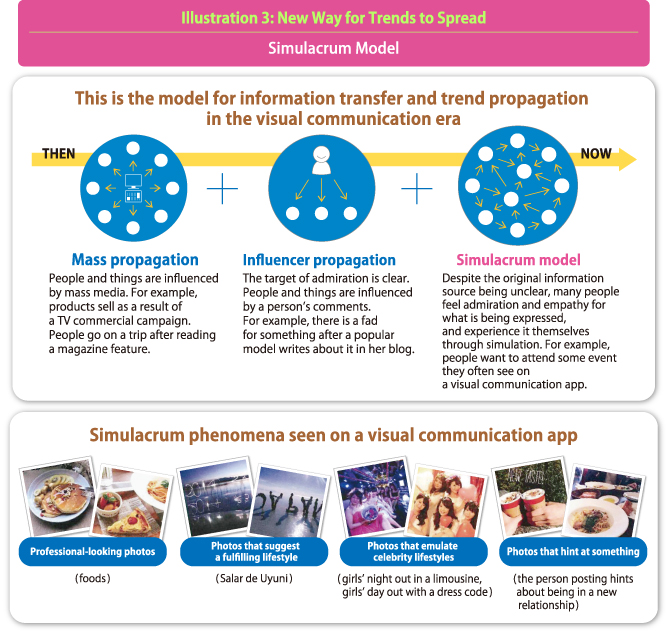Photo apps are a search window onto trend information
The user's log of experiences?built up through photos and videos?becomes an important information source for young people. Nowadays, the young find out about new trends through photo apps, and use this as an information search window when making purchasing decisions. For example, on Instagram, Twitter and other SNSs, it is possible to search for information for a particular purpose using the hashtag. When thinking about how to coordinate one's outfit, one can search using "#ootd" (outfit of the day). If looking for a trendy spot in Tokyo's Daikanyama fashion district, one can input "#daikanyama" and the visuals that appear as a result are increasingly becoming a cue for a mood change or a prompt for actual behavior.
"We are seeing the influence of this trend to search for information using Instagram and other platforms. According to research conducted from April to June last year in the Tokyo area (50 km radius, we observed that males and females aged 10?19 years tended to use major portal sites and search engines less than other age groups. Although searches remain important, for these young segments, information shared on social media is gaining greater presence." (Video Research)
This kind of visual communication is now a key angle when looking for convincing explanations of the changes taking place in the information-related behavior of young people. Further, in the conversations we see daily on social media, we find the differentiated use of subtle nuances (based on the variations in tone and manner across different media) that reflect the user's goal.
For example, we are seeing a tendency to compartmentalize and assign a particular role to each social media platform. Instagram is seen as a very fashionable place with a high concentration of very stylish posts. Twitter is seen as a casual place where diverse people and cultures interact and mix. Facebook is seen as a formal place where the audience is likely to include one's parents and teachers.
Since one can view an enormous volume of information in visual media?where instant information processing is possible?one can ignore things that do not pique one's interest or catch one's eye. Another important point is that if content does not express the world view of the app in question, or does not express a style that matches the mood of users there, the content will not be successful in drawing the audience's attention.
One of the advantages of visual communication is the ability to express things that are difficult to communicate verbally, or to express something without spelling it out. For example, in the case of celebrities, an unexpectedly private scene or a friend's low-key rendezvous may be expressed through a photo or video, and might become an opportunity to create a sense of affinity.
In the case of a company or product, visuals can communicate a world view. Such sharing provides depth when expressing a product's appeal, and we expect it to drive an increase in opportunities for branding or engagement. We are already beginning to see cases of this in practice.

A new information transmission model in the era of visual communication
"We are not sure who started the trend, but a style of photo that everyone wants to imitate is taking on a pattern. Increasingly, admiration of this style and interest in it are being expressed through consumer behavior (see illustration 3). Unlike the conventional 'mass-type' and 'influencer-type' models, in which information comes from an identifiable source and then spreads to influence people and things, a new information transfer model has emerged. The original source of the information in this simulacrum-type model?as we call it?is unclear, but at some point a large number of people share an empathetic response and copy the experience they have observed through the information.
"It is important to note that the three aforementioned models do not operate in isolation, but are mutually dependent. With the models operating in parallel, the contact points arousing consumer wants are diversifying and becoming more frequent."

The primary meaning with which we use the term simulacrum is "a copy without an original." Thus, the original source of information remains unclear, but information from somewhere is copied, and a shared image is created (seemingly, something that everyone would have seen somewhere), which encourages consumer admiration. Hence, the simulacrum refers to a situation in which this image is propagated as a trend. The phenomenon is unique to the era of ubiquitous communication, in which anyone can experience this type of visualization.
The visuals appearing in the simulacrum model are an expression of young people's interests, and we have observed information behavior in which preferences are discovered through a self-feedback mechanism based on visuals communicated by the user. In other words, the place in which visual communication takes place may be seen as an accumulation of insights visualized by young people.
In an era in which it is common for people to make searches of information sourced from content generated by each other, we anticipate that this will develop into places where purchasing behavior takes place directly, through the integration of e-commerce functions and other capabilities. Based on this view, we believe that under such models, the diffusion of audience information and the identification of trends propagated by such actions will continue to grow in importance.
Project members

Kanehito Watanabe
Research and Analysis Department
Marketing Business Division
Video Research Ltd.

Kanako Teramoto
Online and Qualitative Research Department
Marketing Business Division
Video Research Ltd.

Mariko Shitara
Associate Chief Researcher, Media Innovation Research Department
Dentsu Innovation Institute

Akira Amano
Researcher, Media Innovation Research Department
Dentsu Innovation Institute

Kenji Koizumi
Strategic Planner
Strategic Planning Division
Marketing Directors' Group
Dentsu Inc.
